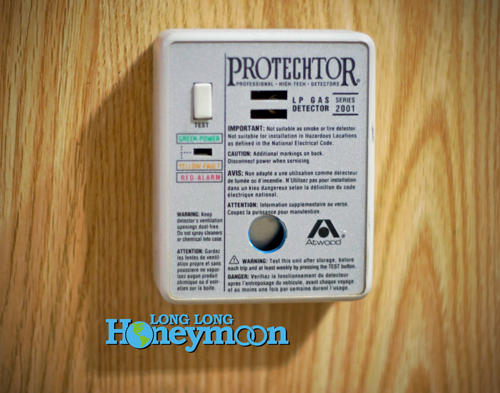Every Airstream or other RV needs to be equipped with a well functioning carbon monoxide detector like the Kidde KOSM-B (http://goo.gl/KVidzj). Carbon monoxide is a colorless, odorless, tasteless gas that causes thousands of deaths each year in North America. Breathing in carbon monoxide is very dangerous. It is the leading cause of poisoning death in the United States.
For a variety of reasons, RV campers are especially vulnerable to carbon monoxide exposure. With an RV, you have a relatively small enclosed living space that contains several potential sources of carbon monoxide. The usual leakage suspects are generators and propane tanks. If a leak occurs, it may not take long for CO levels to reach deadly levels. It can happen when people are sleeping. In this case, they may go to sleep and never wake up.

This is the LP gas detector installed in our Airstream. Since it’s over 10 years old, we’ll probably add one of the Kidde duel smoke / CO detectors to supplement this unit. (Click the pic for more info.)
DEATH AT TALLADEGA
Recently a carbon monoxide poisoning tragedy occurred in the RV camping area at NASCAR’s world famous Talladega Superspeedway in Alabama. One man was killed, while his wife is in critical condition.
The Talladega County Sheriff’s Department said the 46-year old man died at a campground outside the racetrack. He and his 38-year old wife were discovered one morning unresponsive by friends. The wife was airlifted to a nearby hospital, where she remained unconscious and in critical condition. Sadly, the poison managed to shut down many of her internal organs. Even if she survives this ordeal, it’s possible she has suffered irreparable brain and heart damage.
What happened? Police said that carbon monoxide apparently leaked from the exhaust system of the family’s RV. The RV had a broken exhaust pipe on its generator, which was left running all night long– leaking deadly carbon monoxide into the living space while the couple slept.
The incident illustrates the importance of having a well functioning carbon monoxide detector in every RV. One of the most popular detectors on the market is the Kidde detector that includes both smoke and carbon monoxide detection, as well as a talking alarm. The talking feature will allow owners to quickly determine the type of threat.
Most modern era RVs should have carbon monoxide detectors installed by the factory, but some (especially older units) do not. If you RV camp, it’s important to make certain your carbon monoxide detector is functioning properly.

This Kidde model is a #1 bestseller. It offers both smoke and carbon monoxide detection, plus a TALKING alert! (Click the pic for more info.)
Let’s consider some safety advice specific to carbon monoxide.
CARBON MONOXIDE SAFETY TIPS
1. Routinely inspect your generator (especially if you have an internally stored generator) and propane tank connections for leaks and breaks. This is especially true after any kind of road incident (tire blowout, undercarriage damage, RV bottoming out) that might compromise their integrity. On that note, make sure your door and window seals are in good condition, and that there are no holes in the floor.
2. Check your carbon monoxide detector and smoke detector regularly and change the batteries as needed. If you don’t have complete confidence in your old detector, get a new one.
3. Turn off all appliances after use. Never use a propane stove for heat (doing so allows carbon monoxide levels to rise inside the RV interior). When cooking with propane heat, crack open a window or roof vent to promote the flow of air between the interior and exterior. Use the exhaust fan to remove gases from the cooking area.
4. Have an emergency exit plan. Know where the emergency exits are located and be certain everyone is able to open them.
5. Make sure you know how to quickly disconnect all power sources in the event of an emergency.
6. Know the symptoms of carbon monoxide poisoning: headache, dizziness, weakness, nausea, vomiting, confusion and drowsiness. If you experience these symptoms, take them seriously. Many people have discounted these symptoms as simple fatigue; don’t make this potentially fatal mistake.
7. Don’t open windows and roof vents in areas that may contain carbon monoxide. In other words, be aware of the possibility of carbon monoxide outside your RV that could accidentally be drawn inside. This is especially true when camping in close proximity to other RVs and vehicles.
8. Be aware of where you park. Don’t allow exhaust vents to be blocked by snow, tall grass, other RVs, and similar obstructions.
9. If you suspect carbon monoxide poisoning, get outside to fresh air immediately and then call 911.
